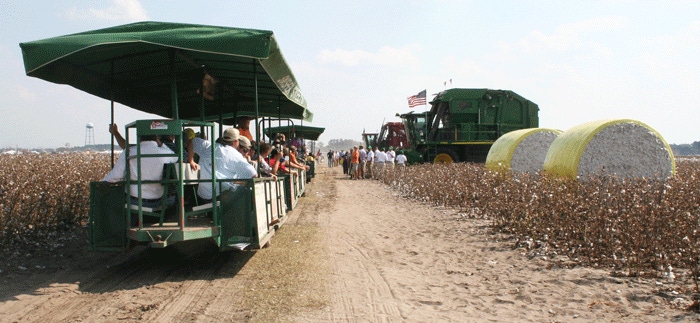
Sunbelt field demonstrations draw crowds
• During each day of the show, Oct. 18-20, there will be equipment demonstrations in the field, weather permitting.• Visitors can take a tractor-drawn covered tram from the exhibit area to the fields where cotton, peanuts, corn, soybeans and hay are being harvested.• On the way, visitors will be able to get off the trams and test-drive any number of new tractors, many with global positioning systems and other precision farming technology.
October 11, 2011

You can always tell the real farmers attending the Sunbelt Agricultural Exposition – while they’re captivated by the smell of new tractors as they enter the show grounds, they’re eventually drawn to the 600-acre working farm where they can view harvest and tillage demonstrations, in addition to test-driving the latest equipment available.
During each day of the show, Oct. 18-20, there will be equipment demonstrations in the field, weather permitting. Visitors can take a tractor-drawn covered tram from the exhibit area to the fields where cotton, peanuts, corn, soybeans and hay are being harvested.
On the way, visitors will be able to get off the trams and test-drive any number of new tractors, many with global positioning systems and other precision farming technology.
The harvesting demonstrations, as well as tillage demonstrations, equipment driving ranges, irrigation technology and precision ag demonstrations all provide opportunities to see and compare a wide range of equipment in an actual working setting. Company representatives and specialists are in the fields to answer visitor questions.
Even in drought-plagued years, the irrigated fields of the Darrell Williams Research Farm at Sunbelt Ag Expo offer attendees a front-row view of the harvesting of the newest crop varieties available to Southeastern growers.
Cotton acreage doubled
For the 2011 production season, the Expo boasts 200 acres of cotton — double the amount of last year’s acreage — to make room for demonstrations of both John Deere and Case IH onboard module builder (OMB) pickers this fall.
Hay harvesting has always been one of the Expo’s most popular field demonstrations, attracting large crowds and offering the widest array of equipment. For the safety of Expo visitors, everyone attending the demonstrations is asked to stand behind the safety ropes in place this year.
Hay tedding, raking, cutting and baling demonstrations will be held each day of the show beginning at 10 a.m., with all times being subject to change depending on weather or equipment.
“We will have something for just about any grower in the Southeast. Each year, we add a little something different, and new things are being added as we get closer to show time” says Michael Williams,” Expo farm manager.
This year, for the first time, Sunn hemp is being grown at the Expo. A potential soil-building cover crop, Sunn hemp is a summer annual legume. “This crop, can provide 100 units of nitrogen and 60 units of potash back into the soil,” says Williams.
While Sunn hemp has the reputation of being one of the best soil-building cover crops in the world, it also has been proven to be an excellent summer deer food plot. According to previous research, the plant grows very fast and typically reaches 6 feet in height in 60 days. It also is a legume so it replenishes the soil with nitrogen.
Within 60 days, it reportedly replenishes the soil with more than 100 pounds of nitrogen, adds 4 tons of organic matter, and suppresses both root-knot and reiniform nematodes. The leaves are 30-percent Nitrogen.
Sunn hemp will grow on very poor acidic soil. However, as any crop, it will perform better on well-drained, fertile soil. It does not grow well on water-logged soils.
The recommended seeding rate is from 15 to 50 pounds per acre. A well-prepared seedbed is suggested. The seed may be broadcast or drilled in, covered 1/4 to 3/4 inches deep.
Sunn hemp may be planted any time after soils warm up in the spring.
About the Author(s)
You May Also Like



